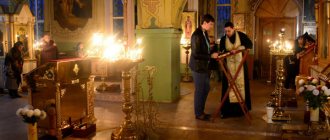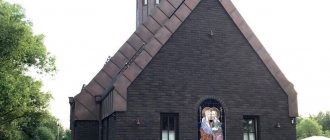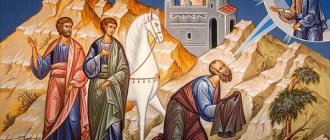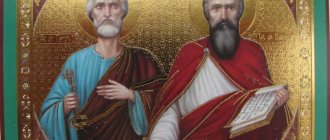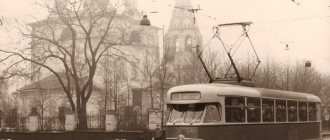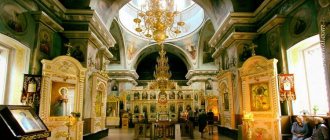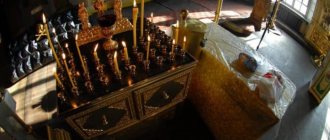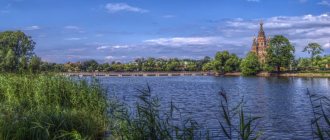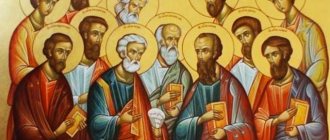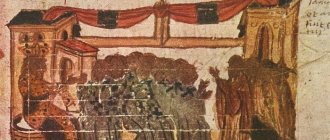| Sergiev Posad Resurrection (Peter and Paul) Church |
Temple in honor of the Resurrection in the city of Sergiev Posad
, often called
the Church of the Supreme Apostles Peter and Paul
, Resurrection Metochion of the Trinity-Sergius Lavra
- Thrones: Resurrection of the Word (main), supreme app. Peter and Paul (altar in the refectory)
- Address: Russia, 141310, Moscow region, Sergiev Posad, st. 1st Shock Army, 17
- Tel.
- Official site:
- On the map: Yandex.Map, Google map
The temple is located in the historical center of the city, in the Kukuevka district, on the territory of the ancient Kalichya Sloboda.
From the northern border of the Lavra to the Church of the Resurrection is about 0.5 km. The original temple on this site was erected by decree of Tsar Alexei Mikhailovich and the blessing of Patriarch Nikon at the expense of the Trinity Sergius Monastery in memory of the thousands of defenders of the monastery who died during the siege of the Lavra by the Polish-Lithuanian army in the Time of Troubles (1608-1610). The wooden Church of the Resurrection of the Word was consecrated in 1654.
In 1775, the dilapidated wooden building was replaced with a new one. In addition, a second temple was built in the settlement, also wooden, consecrated in the name of the apostles Peter and Paul.
After several decades, parishioners raised funds to build a new stone church. Construction work took several years. The consecration of the main altar took place in 1818, in the still unfinished church. Two years later the new church was ready. The temple replaced both of the previous ones, which is why the main altar was consecrated in honor of the Resurrection, and the chapel in the refectory was consecrated in the name of the apostles Peter and Paul. For this reason, the temple became known both as the Resurrection and as the Peter and Paul Church.
By the end of the 19th century, the temple was surrounded by a brick fence with octagonal corner turrets, and in 1902 a western covered brick porch was added to the church.
During the anti-church persecution of the Soviet era, some clergy of the temple accepted death for Christ. Thus, from 1928 to 1931, Hieromartyr Miron Rzhepik served in the church, from 1930 to 1931 - Hieromartyr Nikolai Aristov,
In 1935, the temple was captured by renovationists.
In 1939, by decision of the authorities, the church was closed. The following year, the fence was completely dismantled and the remaining bricks were used for landscaping work at the nearby market. In 1952, the two upper tiers of the bell tower were dismantled. During these years, the temple premises were used for various industries. At the same time, the iconostasis and the entire interior decoration of the temple were completely lost.
In the early 1990s, the church was returned to Orthodox believers. Its restoration began immediately. In 1995, a chapel was erected on the temple site in memory of the fallen soldiers. From 1999 to 2014, three-year Trinity-Sergius theological and catechetical courses operated at the church. At the end of the 2010s, a hotel for pilgrims, a children's educational school and a Sunday school were opened at the temple. The revived temple became the courtyard of the Trinity-Sergius Lavra.
At the beginning of the 21st century, the temple was the only one in Sergiev Posad built according to the canons of classicism at the beginning of the 19th century and was considered an object of cultural heritage of regional significance. Near the temple in 2022, a picturesque park area was landscaped by the city.
Statistics
- 1898 - the temple has more than 180 courtyards with 1143 parishioners
- 1930s - almost 600 people in the parish community
| Sergiev Posad Resurrection Church - Resurrection Metochion of the Trinity-Sergius Lavra |
Story
The construction of the temple is inextricably linked with ancient legend. Once upon a time there was a monastery in these places. In 1608-1610 it was besieged by the Polish-Lithuanian army, Christians found themselves without food and firewood. The siege lasted for 16 long months. Some monks managed to sneak into the nearby forest to get fuel. Many of them died. Bloody battles took place near the walls of the monastery, which claimed the lives of many peasants. They said about this place that it was “sprinkled with Christian blood like raindrops.”
In 1654, in honor of the innocent fallen Christians, they decided to build the Church of the Resurrection of Christ on this site. The construction permit was signed by the sovereign of that time, Alexei Mikhailovich, and Patriarch Nikon gave the blessing. In 1775, the temple building was replaced with a new one, as it had become very dilapidated.
The brick building of the Church of Peter and Paul, which has stood to this day, was erected at the end of 1810. The construction of a single-tower church with a bell tower and a refectory was completed in 1818. In 1820, the consecration ceremony took place. Subsequently, the temple territory was surrounded by a brick fence. At the beginning of the 20th century, the temple changed its appearance. The walls of the building were covered with cement plaster, and a covered porch was added to the western side.
The temple building has a clear, regular shape. Low semicircular apses are attached to it on three sides. The gables of the facades are triangular in shape. The semicircular vault ends with a round drum. A small onion-shaped head on a graceful neck completes the roof of the temple. A refectory is attached to the side of the temple. Its entrances are made in the form of arched spans. The three tiers of the bell tower are of different sizes, decreasing from bottom to top.
With the advent of Soviet power, a ban was imposed on religious services, and they were held extremely rarely. In 1930 the church was completely closed. The temple remained ownerless and stood in disrepair. The lack of supervision and maintenance of the building adversely affected its condition, and it gradually began to collapse. The brick fence was dismantled for the construction of a market located nearby. In the 50s, the bell tower was destroyed, only the lower tier remained intact.
Already in the 50s of the 20th century, the Church of Peter and Paul was returned to believers. The church received the status of a metochion of the Trinity-Sergius Lavra and its restoration began, which continues to this day. The church was restored according to surviving drawings and photographs taken at the beginning of the 20th century. Unfortunately, the interior of the temple suffered greatly during the Soviet years. The iconostasis could not be preserved. Many connoisseurs of antiquity do not like the fact that plastic windows and doors were installed in the cathedral to replace the lost wooden ones.
Schedule of services at the Trinity-Sergius Lavra
Refectory Church and Assumption Cathedral Evening service (9th hour, vespers and matins with 1st hour) – 16.45 All-night vigil – 17.00 Early Liturgy – 6.15 5.30 Late Liturgy – 8.30 After the early and late Liturgy, memorial services are served. In the crypt of the Assumption Cathedral, custom prayer services are served daily (except for the twelve holidays): at 9.00 with blessing of water and at 13.00 without blessing of water. Trinity Cathedral Fraternal prayer service at the relics of St. Sergius, morning prayers and midnight office - 5.30–6.30 Prayer service with akathist Rev. Sergius – 5.00–6.30 Middle Liturgy – 6.30 6.30 Prayers with akathist to St. Sergius – 8.30–20.30 Prayers begin at 8.30; 10.30; 12.30; 14.30; 16.30; 18.30 On Sunday, a cathedral prayer service with an akathist to St. Sergius - 17.00 (if there is no all-night vigil). On Friday, the cathedral prayer service to the Mother of God with an akathist - 17.00 (if there is no all-night vigil). Blessed Oil can be obtained behind the candle box. On the eve of Sundays, twelfths and great holidays, after the all-night vigil with litia, confession is performed (at about 21.00), and on the day of the holiday itself there is an additional middle Liturgy in the Assumption Cathedral at 8.30. The Nadkladeznaya Chapel is open daily from 8.00 to 20.00. Pyatnitskaya Chapel is open daily from 9.00 to 17.00. On Easter, during the days of Great Lent and on some twelfth and patronal feasts, services are performed according to a special schedule. Phone for information.
Gate Church in honor of the Nativity of St. John the Baptist Confession 1st shift – 6.00–7.30 5.00–8.00 Confession 2nd shift – 8.00–10.00 8.00–10.00 Church in honor of the Intercession of the Mother of God at the Moscow Theological Academy Evening service (9th hour, Vespers and Matins from 1 o'clock) - 16.45 All-night vigil - 17.00 Confession in the Academy confessional - 6.00 7.00 Liturgy - 6.20 7.45 On Wednesdays, an akathist to the Intercession of the Mother of God is performed (except for days when the all-night vigil is celebrated) - 18.20 Church of St. John the Climacus in the seminary (entrance from the western side of the Lavra only during divine services) Evening service (9th hour, vespers and matins with 1st hour) – 16.45 All-night vigil – 17.00 No confession in the church vestibule Confession in the church vestibule – 7.00 Liturgy – 6.20 7.30 On Wednesdays (except for days when the all-night vigil is held) the akathist to the Sweetest Jesus and the paraklisis of the Mother of God alternate - 18.20 Church of the Holy Apostles Peter and Paul (located on the north side of the Lavra, 1st Shock Army St., 17, tel.) . Daily Evening service 17.00 Liturgy 7.40 Sacrament of Unction 12.00 The rite of expelling evil spirits (disciplining those possessed) is performed by Archimandrite German on Thursday, Friday and Saturday, except for the Twelve Feasts, at 12.00 in the Church of the Holy Apostles Peter and Paul (Sergiev Posad, st. 1 -th Shock Army). Inquiries by phone. (496) 547-36-45.
What requirements to order Before the service in the churches of the Lavra, you can submit notes about health and repose. Simple notes are left independently in the baskets provided for this purpose, and custom notes are given to the duty officer. For a voluntary donation, in all churches of the Lavra you can order a sorokoust - a prayerful commemoration of a person for forty days. Considering that a large number of pilgrims come to the Lavra every day, we ask you to exercise moderation when writing notes. It would hardly be correct to try to include all close and distant relatives along with all acquaintances on one note. It is better to try to choose 10 - 15 names of those who primarily need your prayer. Custom prayer services are performed in the crypt of the Assumption Cathedral. There you can consecrate the icon or pectoral cross you brought with you. To perform the sacraments of baptism, wedding, funeral service and other requirements, it is better to go to any temple affiliated with the Lavra - since traditionally these services are not performed in monasteries. In the immediate vicinity of the Lavra there are churches of the Pyatnitsky Metochion (on the right side when leaving the Lavra, Red Army Avenue, 127, tel.), as well as the Church of St. Apostles Peter and Paul (behind the Kalichya Tower, 1st Shock Army Ave., 17, tel. (496) 547-36-45). At the Pyatnitsky courtyard, as in the churches of the Lavra, divine services are performed daily. You can submit a commemoration for forty days (Sorokoust), or for a longer period - for six months or for a year. Every week on Sundays before the Divine Liturgy, custom prayer services are held. The prayer service starts at 8.00. In the church of St. Apostles Peter and Paul, which is located outside the walls of the Lavra at the address 1st Shock Army Street, 17, you can order a commemoration at the “unstoppable psalter” - when the reading of the Psalter in the temple goes on constantly and does not stop either day or night. You can give for both the living and the deceased. Candles and prosphora in Lavra churches are distributed as donations. Candles for health should be placed on round candlesticks, for repose - on a canon (a square, low candlestick at the Crucifixion).
How to confess and receive communion In the Trinity Cathedral, the Liturgy begins at 6:30, in the Refectory Church or the Assumption Cathedral at 8:30 - the Liturgy, and at 17:00 - the All-Night Vigil. You can confess on the second floor of the Gate Church of St. John the Baptist. Confession for the early Liturgy begins at 6 am, for the late Liturgy - at 9. See the schedule of confession and services here. Before confession, special prayers are read. Don't be late! Even if you have not prepared for Communion, it is still worth arriving at the beginning of the service. In any case, the time spent in the temple will be gracious and joyful for you. Remember to turn off your mobile phones before entering the temple.
Trips to the Trinity-Sergius Lavra are carried out by tourist
Photos
How Father German reprimands in Sergiev Posad - reviews from believers
The church rite of exorcism from the possessed is performed not far from Moscow on the territory of the monastery of the Holy Trinity St. Sergius Lavra. Archimandrite German (Chesnokov) carries out a mass lecture according to the most ancient canons.
Believers who attended the service talk about the strong impression they received from the ceremony. The feeling of belonging to the divine arises upon entering the gate temple and intensifies during the speech of the clergyman.
The reprimand is preceded by Father Herman's sermon, guiding the believers and penetrating deep into the soul. This is followed by an unusually long special prayer, accompanied by the unnatural muttering and howling of the possessed.
Ordinary people watch with fear how the unclean spirit manifests itself in those possessed by demons. Sprinkling with holy water causes disgusting convulsions in the possessed, animal sounds burst out of their mouths, and people take on terrible forms.
After visiting the lecture three times, believers notice noticeable changes in their daily lives. For some, the ceremony helped in their personal lives; for others, their loved ones were cured of addictions and became kinder and calmer.
From the following article you will learn about the life and work of Hieromonk Photius.
Biography of Father German Chesnokov
Archimandrite German, in the world Alexander, (Chesnokov) was born on August 30, 1941. His entire life is devoted to boundless service to God and activities in the fight against unclean spirits. He strives to introduce the faith and cleanse the souls of the Orthodox from demonic influence.
The biography of Alexander Chesnokov includes military service, admission to the Moscow Automobile and Road Institute, and gradual unity with God. After graduating from the theological academy, Father German becomes a novice of the Lavra, and then a monk of the Trinity-Sergius Monastery.
Cultural heritage
The Church of Peter and Paul in Sergiev Posad is the only architectural monument in the city that dates back to the era of classicism, built in the 19th century. Unfortunately, after the restoration, plastic doors were installed that did not fit into the historical appearance.
Initially, the temple had an important city-forming role, because for most residents of the settlement it was a home church, where all the most important church sacraments were held.
Today, the Church of Peter and Paul is again the center of attraction for believers. It is open to parishioners every day.
Source
